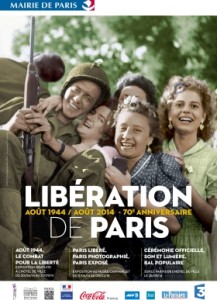It was in August of 1944 that Paris was liberated by the Allies. In particular, by the 2nd Armored Division of the Free French government in exile, based in London.
That was 70 years ago, and the event is being reexamined at the Carnavalet Museum, the official museum of the city of Paris, here in the 4th arrondissement.
And, at long last, the French are getting closer to an accurate account of what went on in the capital, 70 years ago.
For most of a half-century, the official French explanation of the liberation of Paris was that it was done by resistance forces within the city, in tandem with Phillippe Leclerc‘s tanks and men.
That is, of course, silly.
–The Germans had all but abandoned Paris before the French “took” it. Estimates suggest around 5,000 German troops remained inside the city, with perhaps 15,000 near the city — which is nothing, in Second World War numbers. A fair number of those 15,000 probably just happened to be in the area during the general German retreat to the Rhine. Many of the rest were awaiting capture.
–Paris would have been a smoking ruin if the German commanding general in the city had not (largely) ignored Hitler’s orders to burn or blow it up. The city was largely intact before and after the liberation.
–Leclerc’s division may have been the first to enter the city, but it would not have existed without Allied arms (mostly American) and would not have been able to drive into a nearly empty Paris without long, hard battles fought in Normandy by American and British and Canadian forces.
–The French depiction of what happened, the special exhibit suggests, was considered a political necessity by Charles de Gaulle, leader of the Free French and future president of France. The country needed to believe it was a primary agent in throwing off the German yoke — even if the reality was quite different.
I remember visiting the museum in the top of the Arc de Triomphe, in the 1980s, and was astounded to see, via video presentation, that France and the French were pretty much solely responsible for taking Paris from the Germans. Who, of course, had pretty much already left.
The exhibit at Carnavalet is a batch of still images taken by private photographers, with well-translated captions in English (and German), and a few videos.
The most interesting video is a compilation of movies taken without the permission of the French government. They seem to indicate a city nearly devoid of Germans, with a handful of bodies and very little combat. (We see exactly one wrecked German tank.) And the exhibit seems to acknowledge that reality.
We can understand the De Gaulle version of events — France was inert under the Germans, and garrisoned for most of the war by as few as three German divisions. Earlier, the French government had fought against the Allies, in North Africa and the Middle East, and was fairly prompt about turning over to the Germans “undesirables”.
Essentially, it was a collaborationist government, which may have been the smart (and only) play, from June 1940 forward, but didn’t make for much “gloire” by the summer of 1944. The exhibit uses a statistic suggesting as few as 1,300 military firearms were in the hands of the resistance.
The exhibit suggests that history is “what we make of it in the moment” … which perhaps is a delicate way of suggesting that the Liberation of Paris was a sort of non-event followed by some quite unpleasant (and little recorded in France) reprisals against those considered to be too chummy with their now-gone German occupiers.
History can be hard for everyone. Especially the bits that do not flatter us.


0 responses so far ↓
There are no comments yet...Kick things off by filling out the form below.
Leave a Comment